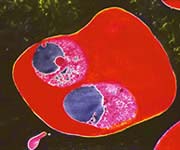New anti-malaria drug

The malaria parasite multiplies in red blood cells, safe from our immune defences <br>© SPL <br>
Monkey tests hint compound could paralyse malaria parasite in humans.
A new-found chemical can root out malaria parasites hiding in red blood cells and stop them reproducing. It may become a much-needed new weapon in the war against one of the world’s biggest killers.
The compound clears monkeys of infection with the human malaria parasite Plasmodium falciparum at doses far lower than existing antimalarial drugs. But testing in humans is a few years away at least, says Henri Vial at Montpellier University in France who discovered the 1.
Developing new antimalarials is essential: malaria kills more than one million people each year, and the parasites are becoming resistant to existing drugs.
Malaria parasites enter our blood when the mosquitoes that carry them bite us. The parasites multiply inside red blood cells, safe from the body’s immune system.
Vial’s team developed a range of compounds that interfere with the building of cell membranes. Rapidly reproducing parasites are constantly making new cell membranes.
They used infected human blood samples to screen all their chemicals for antimalarial activity. A compound with the working name G25 came out on top.
“We were very lucky,” says Vial: G25 only enters red-blood cells that harbour reproducing malaria parasites. Why is a mystery, and “the focus of our research now”, Vial says.
This selectivity is important for two reasons. First, because all animal cells make membranes, G25 would be highly toxic if it were less discerning. More importantly, scientists could exploit the chemical’s nose for malaria-infected cells to deliver other antimalarial compounds. “It is a natural targeting mechanism,” Vial says.
“No other group of drugs works like this,” says Peter Winstanley, who is developing new antimalarial drugs at the University of Liverpool in England. As a result, he hopes G25 could kill even drug-resistant malaria.
But because G25 acts on a fundamental biological system there could be harmful side-effects. Vial’s team saw nothing untoward in monkeys, but admits more work on the safety of the compound is needed.
Another big hurdle is getting the compound into pill form. Currently it has to be injected. “We do have problems with oral absorption,” says Vial. Chemical tweaking of G25 should help.
Scientific obstacles aside, new malaria drugs face an uphill economic struggle, cautions Winstanley. To save the most lives, malaria drugs must be affordable for developing countries where the disease is endemic. Keeping development costs low enough to achieve this is hard.
The newest antimalarial drug on the market costs $57 for a course of treatment. For the developing world “it would need to cost a lot less than 50 cents”, Winstanley says.
References
- Wengelnik, K. et al. A class of potent antimalarials and their specific accumulation on infected erythrocytes. Science, 295, 1311 – 1314, (2002).
Media Contact
More Information:
http://www.nature.com/nsu/020211/020211-11.htmlAll latest news from the category: Health and Medicine
This subject area encompasses research and studies in the field of human medicine.
Among the wide-ranging list of topics covered here are anesthesiology, anatomy, surgery, human genetics, hygiene and environmental medicine, internal medicine, neurology, pharmacology, physiology, urology and dental medicine.
Newest articles

High-energy-density aqueous battery based on halogen multi-electron transfer
Traditional non-aqueous lithium-ion batteries have a high energy density, but their safety is compromised due to the flammable organic electrolytes they utilize. Aqueous batteries use water as the solvent for…

First-ever combined heart pump and pig kidney transplant
…gives new hope to patient with terminal illness. Surgeons at NYU Langone Health performed the first-ever combined mechanical heart pump and gene-edited pig kidney transplant surgery in a 54-year-old woman…

Biophysics: Testing how well biomarkers work
LMU researchers have developed a method to determine how reliably target proteins can be labeled using super-resolution fluorescence microscopy. Modern microscopy techniques make it possible to examine the inner workings…





















